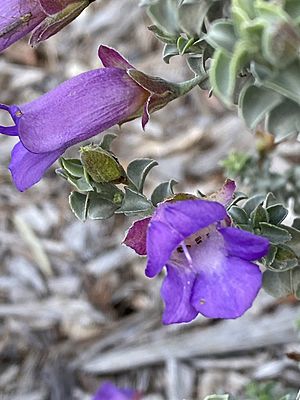Eremophila rotundifolia facts for kids
Quick facts for kids Eremophila rotundifolia |
|
|---|---|
 |
|
| In the Mount Annan Botanic Garden | |
| Scientific classification | |
| Genus: |
Eremophila (plant)
|
| Species: |
rotundifolia
|
| Synonyms | |
|
|
Eremophila rotundifolia is a special flowering plant found only in Australia. It belongs to the figwort family, which is also known as Scrophulariaceae. This plant is a shrub with many branches that often look tangled. Its leaves and branches are covered with soft, silvery-grey hairs, making it look quite unique. The flowers of this plant can be different shades of lilac, from very pale to a deep purple. You can often find it growing in South Australia, and there's also one known spot in the Northern Territory.
Contents
What Does This Plant Look Like?
Eremophila rotundifolia is a shrub that can grow between 1 and 3 m (3 and 10 ft) tall. It has many branches that can look a bit tangled.
Branches and Leaves
Both the branches and the leaves of this plant are covered in soft, silvery-grey hairs. These hairs lie flat against the surface. The branches can feel a bit lumpy because old leaf bases stay on them for a long time. The leaves are thick and stiff. They are shaped like an egg or a fan, usually about 8–14.5 mm (0.3–0.6 in) long and 6–13 mm (0.2–0.5 in) wide. They are often folded into a U-shape and curve downwards. The leaves grow close together at the ends of the branches and have a short, flat stalk about 2–5 mm (0.08–0.2 in) long.
Flowers
The flowers grow one by one where the leaves meet the stem. Each flower sits on a hairy stalk that is about 8–13 mm (0.3–0.5 in) long. Before the flower opens, it has 5 overlapping, hairy, yellowish-green to purple sepals. Sepals are like small leaves that protect the bud. These sepals are about 9.5–16.5 mm (0.4–0.6 in) long.
The petals of the flower are 25–30 mm (0.98–1.2 in) long. They are joined together at the bottom to form a tube. The outside of this tube can be pale lilac to deep purple, and sometimes even white. Inside the tube, it's white with violet spots. The outside of the petals and their tips are hairy, but the inside of the tips is smooth (this is called glabrous). The inside of the tube is full of long, soft hairs. There are 4 stamens (the parts that make pollen) hidden inside the petal tube.
Fruits
Eremophila rotundifolia usually flowers from May to October. After the flowers, the plant produces dry, woody, oval-shaped fruits. These fruits are about 7–8 mm (0.28–0.31 in) long and have a hairy, papery covering.
How it Got its Name
This plant was first officially described in 1859 by a scientist named Ferdinand von Mueller. He published his description in a book called Fragmenta phytographiae Australiae.
The plant's scientific name, rotundifolia, comes from two Latin words. Rotundus means "circular" or "round," and folia means "leaves." So, the name basically means "round-leaved."
Where Does This Plant Grow?
Eremophila rotundifolia is quite common in South Australia. It likes to grow in stony soils in several different plant regions there, including the North-western, Lake Eyre, Nullarbor, Gairdner-Torrens, and Eyre Peninsula areas. There is also one known place where it grows near Charlotte Waters in the Northern Territory.
Is This Plant in Danger?
In the Northern Territory, Eremophila rotundifolia is listed as "near threatened." This means that while it's not in immediate danger of disappearing, its numbers are getting low, and it could become threatened if we don't protect its habitats.
Growing This Plant
Eremophila rotundifolia is a great plant for gardens. Its silvery-grey leaves look beautiful next to its lilac to purple flowers. It also creates a nice contrast with other plants, especially those with dark green leaves.
You can grow this plant from cuttings, which means taking a piece of the plant and helping it grow roots. However, it can be slow to start growing this way. It's often easier to grow it by grafting it onto a Myoporum rootstock. This means joining a piece of Eremophila rotundifolia onto the roots of a Myoporum plant.
This plant grows best in soil that drains well and in a sunny spot. It's also very good at handling dry weather, so it only needs a deep watering once or twice during a long dry period. It can handle a little bit of frost, but not too much. If it gets damaged by a light frost, you can prune the damaged parts, and the plant will usually recover.

